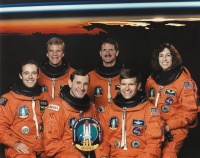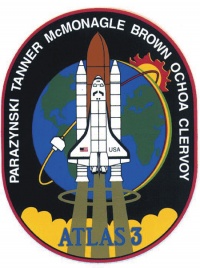STS-66
From The Space Library
 | |
| Organization | NASA-Office of Space Flight (United States) |
|---|---|
| Mission type | Human Crew |
| Launch date | November 3, 1994 |
| Launch vehicle | Space Shuttle |
| Launch site | Cape Canaveral, United States |
| COSPAR ID | 1994-073A |
| Inclination | 57 degrees |
| Experiments | Here |
| Alternate Names | 23340 |
| Additional Information | Here |
| Data Collection | Here |
| Payload Mass Up | 10544 kg |
| Payload Mass Down | 10566.82 kg |
| Orbiter | Atlantis |
| Lift Off Mass | 2,049,258.64 kg |
| Orbiter Weight at Liftoff | 110,835.91 kg |
| Orbiter Weight at Landing | 95,382.73 kg |
| Landed | Concrete runway 22 at Edwards Air Force Base, Calif. |
| Orbits of Earth | 174 |
| Orbital Altitude | 164 nautical miles (189 statute miles) |
Contents |
Crew
- Commander: Donald R. McMonagle
- Pilot: Curtis L. Brown Jr.
- Payload Commander: Ellen Ochoa
- Mission Specialist 1: Scott E. Parazynski
- Mission Specialist 2: Joseph R. Tanner
- Mission Specialist 3: Jean-Francois Clervoy, European Space Agency
Mission
STS-66, a US Shuttle mission, was launched from Cape Canaveral. The primary payload was the Atlas 3 laboratory containing two instruments (SOLCON and SOLSPEC) to measure solar emissions in the visible and UV bands, and a UV backscatter monitor to measure ozone concentrations. The Shuttle also carried many pregnant and non-pregnant rats for biological studies. STS-66 further advanced a comprehensive effort to collect data about the sun's energy output, the chemical makeup of the Earth's middle atmosphere, and how these factors affect global ozone levels. Seven instruments on the Atmospheric Laboratory for Applications and Science-3 (ATLAS-3) also flew on the first two ATLAS flights. No other collection of space-based instruments provided the same extensive range of atmospheric measurements. Also considered a primary payload was the Cryogenic Infrared Spectrometers and Telescopes for the Atmosphere-Shuttle Pallet Satellite (CRISTA-SPAS), continuing joint NASA-German Space Agency (DARA) series of scientific missions. ATLAS-3 and CRISTA-SPAS were considered a joint mission with a single set of science objectives. During the mission, the crew divided into two teams for around-the-clock research. The ATLAS-3 instruments, mounted on a Spacelab pallet in the cargo bay, included the Atmospheric Trace Molecule Spectroscopy (ATMOS), which collected more data on trace gases in the atmosphere than on all three of its previous flights combined; the Shuttle Solar Backscatter Ultraviolet Spectrometer (SSBUV), which took ozone measurements to calibrate ozone monitor on an aging NOAA-9 satellite as well as cooperative measurements with other ATLAS-3 instruments; the Active Cavity Radiometer Irradiance Monitor (ACRIM), which took extremely precise measurements of the sun's total radiation for 30 orbits as calibration reference for a sister instrument on the Upper Atmosphere Research Satellite (UARS) launched in 1991; the Measurement of the Solar Constant (SOLCON), provided by Belgium, which also measured solar radiation but as a reference point to track changes over years; the Solar Spectrum Measurement (SOLSPEC), a French instrument, measured the sun's radiation as function of wavelength; and the Solar Ultraviolet Spectral Irradiance Monitor (SUSIM), which collected its highest precision solar ultraviolet radiation measurements in its 15-year lifetime. The Millimeter Wave Atmospheric Sounder (MAS), collected nine hours of observations, measuring the distribution of water vapor, chlorine monoxide and ozone at altitudes between 12 and 60 miles (20-100 kilometers), before a computer malfunction halted instrument operations. CRISTA-SPAS released from orbiter's Remote Manipulator System arm on second day of mission. Flying at distance of about 25-44 miles (40-70 kilometers) behind Shuttle, payload collected data for more than eight days before being retrieved and returned to cargo bay. CRISTA instrument gathered first global information about medium- and small- scale disturbances in trace gases in middle atmosphere, which could lead to better models of the atmosphere and Earth's energy balance. Second CRISTA-SPAS instrument, the Middle Atmosphere High Resolution Spectrograph Investigation (MAHRSI) measured amounts of ozone-destroying hydroxyl and nitric oxide in the middle atmosphere and lower thermosphere from 24-72 miles (40-120 kilometers). MAHRSI yielded first complete global maps of hydroxyl in atmosphere. For retrieval of CRISTA-SPAS, a different approach method to the spacecraft was successfully tested as a prelude to upcoming U.S. Shuttle/Russian Space Station Mir docking flights. Called the R-Bar approach, it is expected to save propellant while reducing the risk of contamination to the Mir systems from orbiter thruster jet firings.
Payload
Atmospheric Laboratory for Applications and Science (ATLAS) 3; Cryogenic Infrared Spectrometers and Telescopes for the Atmosphere (CRISTA)-Shuttle Pallet Satellite (SPAS) 1; Experiment of the Sun for Complementing the ATLAS Payload for Education (ESCAPE) II; Inter-Mars Tissue Equivalent Proportional Counter (ITEPC); Shuttle Solar Backscatter Ultraviolet (SSBUV) A; Physiological and Anatomical Rodent Experiment (PARE/NIH-R); Protein Crystal Growth (PCG-TES and PCG-STES); Space Tissue Loss (STL/NIHC-A); Shuttle Acceleration Measurement System (SAMS); Heat Pipe Performance (HPP)
Books about the Space Shuttle Program
Buy This Book Click here |
Buy This Book here |
Buy This Book Click here |
Buy This Book Click here |





